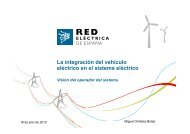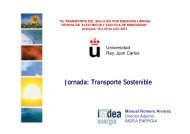Del oro negro al oro verde. Retos pendientes para un transporte ...
Del oro negro al oro verde. Retos pendientes para un transporte ...
Del oro negro al oro verde. Retos pendientes para un transporte ...
You also want an ePaper? Increase the reach of your titles
YUMPU automatically turns print PDFs into web optimized ePapers that Google loves.
<strong>Del</strong> <strong>oro</strong> <strong>negro</strong> <strong>al</strong> <strong>oro</strong> <strong>verde</strong>.<br />
<strong>Retos</strong> <strong>pendientes</strong> <strong>para</strong> <strong>un</strong> <strong>transporte</strong> sostenible<br />
Prof. Pedro Gómez-Romero<br />
NEO-Energy, NEO Energy, CIN2 (CSIC (CSIC-ICN), ICN), Barcelona, Spain. MATGAS Research Center<br />
Cursos de Verano URJC 2012<br />
El Transporte del s. XXI
El problema bl dde lla energía<br />
í
Consumo soci<strong>al</strong> de energía<br />
Energía exosomática<br />
Fuente: G. Tyler Miller Jr. “Living in the Environment” 11th Ed. Brooks/Cole, 2000
100 W
400 W
1000 W
2400 W
100CV 73600 W
4x4 VW Touareg<br />
313CV 230000 W
VW Touareg tirando de <strong>un</strong> Boeing 747<br />
747 power p thrust 4x50000 lbs force<br />
aprox. 200 MW (200,000,000 W)
Necesidades N NNecesidades id d d de potencia t i d de l los h humanos ( (ca ca. . 2000)<br />
12TW = 12,000,000,000,000 vatios<br />
100 vatios /humano<br />
120,000,000,000 humanos<br />
66,000,000,000 000 000 000 humanos/Tierra<br />
20 Tierras
¿ cómo es nuestro perfil de consumo<br />
d de energía í y cómo ó va a evolucionar l i ?<br />
?<br />
12<br />
28 28 TW<br />
12 TW<br />
1TW = 10 W 12TW = 12,000,000,000,000 W
15 TW<br />
World Energy Consumption by Source, Based on Vaclav Smil estimates from<br />
Energy Transitions: History, Requirements and Prospects together with BP<br />
Statistic<strong>al</strong> Data for f 1965 and subsequent q
15 TW<br />
2050<br />
28 TW
Per capita world energy consumption, c<strong>al</strong>culated by dividing world<br />
energy consumption by population estimates, based on Angus<br />
MMaddison ddi data.<br />
d t
¿Por qué qué estamos estamos tan tan seguros de<br />
que el consumo de energía glob<strong>al</strong><br />
seguira creciendo?<br />
China<br />
En <strong>un</strong>a p<strong>al</strong>abra....
Consumo soci<strong>al</strong> de energía exosomática<br />
Pedro Gómez Romero “Un planeta en busca de energía” (Ed. Síntesis, 2007)
¿de dónde s<strong>al</strong>e toda esa energía?
Fotovoltaica<br />
E Energía í solar l<br />
Carbón<br />
Térmica<br />
65 M.años de Sol (hace 300 M. años)<br />
Petróleo<br />
Microorg. Marinos de hace 10 10-200 200 M. años<br />
Gas natur<strong>al</strong><br />
Biomasa<br />
Sol reciente en conserva<br />
Hidroeléctrica<br />
Eóli Eólica Vig<strong>oro</strong>so clima cuyo motor es el Sol<br />
Nuclear, Geotérmica, Mareas
Un siglo (0.0001 Millones de años) quemando<br />
nuestro capit<strong>al</strong> de combustibles fósiles<br />
¿Es sostenible esta situación?
El quemar se va a acabar<br />
K. Hubert (USA)<br />
La producción de crudo en los EEUU (arriba) <strong>al</strong>canzó su máximo en 1970, siguiendo las predicciones.<br />
CCuando d lla producción d ió m<strong>un</strong>di<strong>al</strong> di l <strong>al</strong>cance l el l suyo se hhabrá b á acabado b d <strong>para</strong> siempre i el l petróleo t ól bbarato t<br />
(Courtesy: Science, vol. 281, Aug. 21,1998, p.1128; C. Campbell & J. Laherrere)
Esquema de la evolución histórica y prevista de la producción de petróleo glob<strong>al</strong>.<br />
Esta gráfica de “servilleta de bar” (“back of the envelope” en inglés), es tan buena<br />
como cu<strong>al</strong>quier otra, en ausencia de estimaciones fiables de las reservas glob<strong>al</strong>es de<br />
petróleo (¿<strong>al</strong>guien sabe cuánto queda bajo los desiertos de Arabia Saudita?). Saudita?)<br />
Pedro Gómez Romero. Revista Mètode (Univ. de V<strong>al</strong>ència) Nº 65, Primavera 2010, p. 75-79
120<br />
100<br />
80<br />
60<br />
40<br />
20<br />
0<br />
1900<br />
Después de <strong>un</strong> siglo de energía barata:<br />
Adictos <strong>al</strong> petróleo<br />
U.S. Crude Oil First Purchase Price (Dollars per Barrel)<br />
1903<br />
1906<br />
1909<br />
1912<br />
1915<br />
1918<br />
1921<br />
1924<br />
1927<br />
1930<br />
1933<br />
1936<br />
1939<br />
1942<br />
1945<br />
1948<br />
1951<br />
1954<br />
1957<br />
1960<br />
1963<br />
1966<br />
Source US EIA<br />
http://www.eia.gov/dnav/pet/hist/LeafHandler.ashx?n=pet&s=f000000 p g p p __3&f=a<br />
1969<br />
1972<br />
1975<br />
1978<br />
1981<br />
1984<br />
1987<br />
1990<br />
1993<br />
1996<br />
1999<br />
2002<br />
2005<br />
2008<br />
2011
Producción glob<strong>al</strong> de petróleo<br />
4000<br />
4500<br />
g p<br />
2500<br />
3000<br />
3500<br />
Toneladas<br />
1000<br />
1500<br />
2000<br />
Millones de<br />
0<br />
500<br />
1000<br />
965<br />
967<br />
969<br />
971<br />
973<br />
975<br />
977<br />
979<br />
981<br />
983<br />
985<br />
987<br />
989<br />
991<br />
993<br />
995<br />
997<br />
999<br />
001<br />
003<br />
005<br />
007<br />
009<br />
19<br />
19<br />
19<br />
19<br />
19<br />
19<br />
19<br />
19<br />
19<br />
19<br />
19<br />
19<br />
19<br />
19<br />
19<br />
19<br />
19<br />
19<br />
20<br />
20<br />
20<br />
20<br />
20
Millones de Toneladas<br />
4500<br />
4000<br />
3500<br />
3000<br />
2500<br />
2000<br />
1500<br />
1000<br />
500<br />
0<br />
1965<br />
1967<br />
PProducción d ió y consumo glob<strong>al</strong> l b l dde petróleo t ól<br />
1969<br />
1971<br />
1973<br />
1975<br />
1977<br />
1979<br />
1981<br />
1983<br />
1985<br />
1987<br />
1989<br />
1991<br />
1993<br />
1995<br />
1997<br />
1999<br />
2001<br />
2003<br />
2005<br />
2007
Millones de Toneladas T<br />
200<br />
150<br />
100<br />
50<br />
0<br />
-50 50<br />
-100<br />
-150<br />
1965<br />
1967<br />
Diferencia Producción<br />
Producción-Consumo Consumo petróleo glob<strong>al</strong><br />
1969<br />
1971<br />
1973<br />
1975<br />
1977<br />
1979<br />
1981<br />
1983<br />
1985<br />
1987<br />
1989<br />
1991<br />
1993<br />
1995<br />
1997<br />
1999<br />
2001<br />
2003<br />
2005<br />
2007<br />
2009
World oil price predictions<br />
Source Source: : EIA, , Energy gy Information Administration (“Internation<strong>al</strong> ( Energy gy Outlook”, , IEO). )
World oil price predictions<br />
Source Source: : EIA, , Energy gy Information Administration (“Internation<strong>al</strong> ( Energy gy Outlook”, , IEO). )<br />
IEO 2010
¿La solución <strong>al</strong> <strong>negro</strong> panorama de la energía?<br />
fuentes<br />
RENOVABLES<br />
de energía primaria<br />
Combustibles<br />
Co bust b es<br />
más LIMPIOS<br />
AHORRO<br />
Y<br />
EFICIENCIA ENERGÉTICOS
La ciencia La nanociencia <strong>al</strong> rescate <strong>al</strong> rescate de la la energía energía
Electro‐<br />
org. Si<br />
crómicos<br />
Term<br />
Ahorro y blancos<br />
Conc. PV OLEDs<br />
PE<br />
nano‐Au<br />
Comb<br />
fósiles<br />
Nuclear<br />
Biocombustibles<br />
2ª 2<br />
Generación<br />
Biogas<br />
E‐Térmica<br />
Generación<br />
renovable<br />
FCs<br />
eficiencia<br />
H 2 H<br />
Ilumina‐ l i<br />
ción<br />
H2 <strong>al</strong>macenamiento<br />
LEDs<br />
Baterías<br />
Supercon‐<br />
densadores<br />
Condensa‐<br />
dores<br />
E‐Térmica S<strong>al</strong>es<br />
f<strong>un</strong>didas<br />
C<strong>al</strong>or<br />
lt latente t
2<br />
1<br />
17 16<br />
20<br />
WO3 Electro‐<br />
CdSe<br />
org. Si<br />
crómicos<br />
Term<br />
Ahorro y blancos<br />
Conc. PV OLEDs<br />
3 18<br />
7<br />
4<br />
6<br />
8<br />
5<br />
GaAs<br />
Clatratos<br />
9<br />
PE<br />
nano‐Au<br />
Comb<br />
fósiles<br />
Nuclear<br />
Biocombustibles<br />
2ª 2<br />
Generación<br />
10<br />
Biogas<br />
E‐Térmica<br />
Generación<br />
renovable<br />
FCs<br />
eficiencia<br />
H 2 H<br />
Ilumina‐ l i<br />
ción<br />
H2 <strong>al</strong>macenamiento<br />
LEDs<br />
Li 4Ti 5O 12<br />
Alq 3<br />
19<br />
InGaN<br />
Baterías Supercon‐ RuO 2<br />
14<br />
densadores<br />
Condensa‐<br />
C p<strong>oro</strong>sos<br />
dores<br />
E‐Térmica S<strong>al</strong>es<br />
f<strong>un</strong>didas<br />
C<strong>al</strong>or<br />
lt latente t<br />
C p<strong>oro</strong>sos, Nanotubos C<br />
Hidruros, MOFs<br />
12<br />
Nitratos<br />
11<br />
11<br />
13<br />
15
De recolectores a agricultores<br />
Despídase de su combustible “primario”<br />
y<br />
Elija su vector energético favorito<br />
Corto plazo: Biocombustibles<br />
Bi Biodiesel di l (20% bi bio 80% di diesel), l) ( (oleaginosas)<br />
l i )<br />
Bioetanol (con Gasolina)(carbohidratos/azúcares)<br />
Medio plazo: Baterías recargables <strong>para</strong> tracción eléctrica de<br />
vehículos?<br />
Medio-Largo plazo: Pilas de Hidrógeno (Pilas de Combustible)<br />
HH2... El combustible b tibl ddel l ffuturo? t ?
Biocombustibles<br />
Nation<strong>al</strong> USA<br />
Internation<strong>al</strong>
<strong>al</strong>midón<br />
celulosa
DOE: ca. 40000 Km Km2 required to replace <strong>al</strong>l<br />
petroleum fuel in the USA<br />
by <strong>al</strong>gae<br />
Chlorella vulgaris<br />
Biocombustibles 3G
Coches de ayer, de hoy y de mañana<br />
B.G. Pollet, et <strong>al</strong>., Current status of hybrid, battery and fuel cell electric vehicles: From electrochemistry to market prospects, Electrochim. Acta (2012)<br />
41
Electrification of road transport<br />
lless th than hh<strong>al</strong>f lf ffuel l ( (and d CO CO2) ) per car !<br />
simpler CO 2 capture<br />
zero noise i and d pollution ll ti iin urban b areas<br />
combined cycle<br />
power plant (η ~60%)<br />
42
Well Well-to to-Wheel Wheel Energy gy An<strong>al</strong>ysis y<br />
electicidad de centr<strong>al</strong> térmica<br />
de ciclo combinado (64%)<br />
Fuente: Electric vehicle market penetration in Switzerland by 2020 (Alpiq)<br />
43
Well Well-to to-Wheel Wheel Energy gy An<strong>al</strong>ysis y<br />
menos de la mitad de combustible (y CO2) por coche<br />
captura de CO2 más simple<br />
sin ruido ni polución en areas urbanas<br />
Fuente: Electric vehicle market penetration in Switzerland by 2020 (Alpiq)<br />
44
H H2 ... ¿el l combustible b tibl del d l futuro?... f t ?<br />
Revoluciones Revoluciones <strong>pendientes</strong>:<br />
• Generación H2 renovable<br />
• Almacenamiento eficaz<br />
• Pilas de Combustible mejoradas<br />
Honda FCX 2005<br />
Coche de hidrógeno
S. Satyap<strong>al</strong>. 2011 Annu<strong>al</strong> Progress Report . DOE Hydrogen and Fuel Cells Program<br />
http://www.hydrogen.energy.gov/pdfs/progress11/i_introduction_2011.pdf
Generación loc<strong>al</strong><br />
estacionaria<br />
MTU (Daimler Chrysler)<br />
HotModule HM 300 fuel cell for<br />
stationary applications 280kW<br />
Tipos p de aplicaciones<br />
p<br />
Transporte<br />
Honda FCX 2005<br />
Coche de hidrógeno<br />
Miniaturización<br />
Toshiba March 2003<br />
Pilas de combustible <strong>para</strong><br />
ordenadores portátiles<br />
20h de autonomía.
Hidrógeno, g , p<br />
Hidrógeno, las revoluciones <strong>pendientes</strong><br />
sostenible eficiente barato duradero<br />
Generación X X X X<br />
Almacenamiento X X X<br />
Uso en FC X X
http://www.hydrogen.energy.gov/annu<strong>al</strong>_review12_storage.html
C Combustión b tió frente f t a conversión ió electroquímica<br />
l t í i<br />
Energía Energía 40%<br />
Química Eléctrica<br />
Pilas de combustible<br />
conversión electroquímica<br />
di directa t<br />
Energía<br />
Térmica<br />
Energía<br />
Mecánica<br />
Limitación termodinámica intrínseca (ciclo de Carnot)<br />
20%
Revoluciones <strong>pendientes</strong><br />
Pilas de Combustible PEM:<br />
Membranas<br />
Cat<strong>al</strong>izador
Revoluciones <strong>pendientes</strong><br />
Generación sostenible sostenible de de H H 2
¿El hidrógeno crece en los árboles?<br />
aire<br />
H 2 ,<br />
portador de energía,<br />
combustible sec<strong>un</strong>dario<br />
vector t energético<br />
éti
El Hidrógeno será tan <strong>verde</strong><br />
como lo sea la energía<br />
empleada <strong>para</strong> generarlo
Producción Producción de de Hidrógeno<br />
Hidrógeno<br />
Reformado<br />
CH 4 + H 2O(g) 3H 2 + CO<br />
CO + H 2O(g) CO 2 + H 2<br />
Fihri AA, Artero V, V Razavet MM, Baffert CC, Leibl WandFontecave W and Fontecave M<br />
90 90-95% 95% ddel l H H2 generado d en el l m<strong>un</strong>do d<br />
Cob<strong>al</strong>oxime-based photocat<strong>al</strong>ytic devices for hydrogen production.<br />
Angewandte Chemie Internation<strong>al</strong> Edition, 2008, 47(3): 564-567<br />
Eficiencia 85%
Renewable Hydrogen<br />
Direct electrochemic<strong>al</strong> production<br />
of fhhydrogen d induced i d db by s<strong>un</strong>light li ht<br />
• Potenti<strong>al</strong>ly more efficient than PV<br />
electrolysis<br />
• Still early in development<br />
Photoelectrochemic<strong>al</strong><br />
Hydrogen
Renewable Hydrogen<br />
Bio-Hydrogen<br />
Another potenti<strong>al</strong>ly p yhigh g<br />
efficiency technology for<br />
hydrogen production<br />
using i solar l energy
Electricidad ¿fuente limpia de energía?
Wanted:<br />
primary energy sources<br />
(for a not not-too-far-away too far away future)<br />
convention<strong>al</strong><br />
convention<strong>al</strong>: ti l<br />
CH CH4 as transition fuel<br />
Nuclear energy (fissión fissión) ) as necessary evil evil?<br />
Alternative/<br />
Alternative/renewable<br />
Alternative/<br />
Alternative/renewable renewable<br />
Wind<br />
Solar Solar Energy Energy (therm<strong>al</strong>, (therm<strong>al</strong> photovoltaic photovoltaic...)<br />
)<br />
Nuclear Fusion
¿La solución <strong>al</strong> <strong>negro</strong> panorama de la energía?<br />
fuentes<br />
RENOVABLES<br />
de energía primaria<br />
Combustibles<br />
Co bust b es<br />
más LIMPIOS<br />
AHORRO<br />
Y<br />
EFICIENCIA ENERGÉTICOS
Fuentes primarias: ¿Sol arcaico o moderno?<br />
1 EJ = 1 exajoule or 10 18 joules or ∼163 million barrels of oil.<br />
Data source: German Feder<strong>al</strong> Institute for Geosciences and Natur<strong>al</strong> Resources
E Energías í renovables bl<br />
Hidro<br />
GGeotérmica té i<br />
Eólica óca<br />
Biomasa<br />
Potenci<strong>al</strong> o e c a teórico… eó co y ppráctico ác co<br />
4.6 TW …1.5 TW<br />
12 12-30TW 30TW<br />
50 TW … 2 TW<br />
7-12 TW …5-7 TW<br />
Solar 120000 TW…600TW<br />
Nathan S Lewis<br />
Nathan S. Lewis,<br />
C<strong>al</strong>ifornia Institute of Technology
¡El futuro futuro está está aquí!<br />
aquí!<br />
PS10 y PS20 centr<strong>al</strong>es eléctricas Termosolares (Abengoa Abengoa) ) en Sanlúcar (Sevilla)
parque eólico de Sisante<br />
(Iberdrola)<br />
¡El futuro está aquí!<br />
Huerto solar en Castilla La Mancha. Solaer
Potencia eólica inst<strong>al</strong>ada en España (MW)<br />
Acumulados 19 GW<br />
31 Dec 2010: 20 / 16 % electricidad
Evolución del consumo de petróleo <strong>para</strong> países del G7<br />
(1980-2007)<br />
(1980 2007)<br />
Change in petroleum consumption for G7 co<strong>un</strong>tries from 1980 to 2001.<br />
Data source: U.S. Department p of Energy, gy, Energy gy Information Administration.<br />
Compilation and chart: Nanowerk)
en definitiva...<br />
• No podemos p “esperar p a ver qqué ppasa”.<br />
Actuar YA!<br />
• No debemos detenernos en “g<strong>al</strong>gos o podencos”<br />
• Urge <strong>un</strong>a política proactiva <strong>para</strong> desarrollar/favorecer<br />
energías (y combustibles!) limpi@s, renovables<br />
capaces de <strong>al</strong>imentación masiva (2050, 28 TW)<br />
• Necesitamos <strong>un</strong>a Re-evolución tecnológica basada en<br />
revolución(es) ( ) científica(s) ( ) qque<br />
incluirá el desarrollo de<br />
movilidad sostenible basada en tracción eléctrica<br />
• Urge <strong>un</strong> plan estratégico con prioridad de “Seguridad<br />
Nacion<strong>al</strong>” (e internacion<strong>al</strong>). PERO todos podemos<br />
contribuir
¿Otras fuentes de energía?<br />
¿Y Yllas nucleares? l ?<br />
¿Energía de fusión?<br />
Chi China, ¿fuente f t de d soluciones? l i ?<br />
Economía o Medio Ambiente<br />
LLas facturas f t de d la l Tierra Ti<br />
¿Y el agujero de ozono?<br />
¿C ¿Cabe b esperar <strong>un</strong> milagro? il ?<br />
More popular popular science at<br />
www.cienciateca.com<br />
(Ed. Síntesis, 2007)
Queda Q mucho p por hacer....<br />
pero estamos moldeando la historia del futuro.<br />
entre todos d<br />
En solitud, però no solitaris,<br />
reconduïm la vida, , amb la certesa<br />
que cap esforç no cau en terra eixorca.<br />
Dia vindrà que <strong>al</strong>gú beurà a mans plenes<br />
l'aigua de llum que brolli de les pedres<br />
d'aquest temps nou que ara esculpim nos<strong>al</strong>tres.<br />
Miquel Martí i Pol SOLSTICI<br />
Para saber más<br />
www.cienciateca.com
Prof Prof. Pedro Pedro Gómez Gómez-Romero Romero
J Jullieth lli th S SSuárez Suárez-Guevara<br />
á GGuevara Prof Prof. Pedro Pedro Gómez Gómez-Romero Romero<br />
Omar Ayyad<br />
Cu@PPy nanocables<br />
Agar materi<strong>al</strong>s materi<strong>al</strong>s, , Li Batt<br />
Supercaps<br />
Judith Oró Oró-Solé Solé<br />
TEM Dr. David Muñoz Muñoz-Rojas Rojas<br />
Ag@PPy nanosnakes<br />
Presently Dept Mat Science & Met<br />
U. Cambridge<br />
Dr. Vanesa Ruiz<br />
Supercaps
















